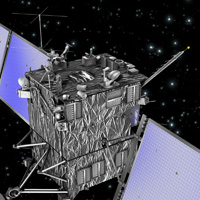Rosetta's scientific instruments ready for close encounter with Steins
5 September 2008
As the Rosetta spacecraft closes in on asteroid Steins the science instruments are prepared for this extraordinary opportunity to study a rare, E-type asteroid. Final orbit trajectory corrections have been performed and the spacecraft is now on track for a closest approach at 20:58 CEST at a distance of 800±2 km. |
|
Rosetta's instruments are located on one side of the spacecraft |
Detailed planning for the science operations for this campaign has been performed by the team at the Rosetta Science Operations Centre (RSOC), in close collaboration with the instrument teams and with the Rosetta Mission Operations Centre (RMOC) team based at ESOC. The RSOC team collated the operations requests provided by each of 11 instruments, ensured an optimum observing programme for this unique encounter by taking account of any operational constraints or conflicts, and provided the resulting consolidated operation requests to RMOC for implementation.
Science instruments prepare for the fly-by
Since 20 August the OSIRIS camera has been making regular observations of asteroid Steins as part of the optical navigation campaign. In addition a number of dedicated observations have been performed with this camera in order to characterise the light curve of the asteroid.
Starting 1 September the remaining instruments have been switched on, one-by-one, and they are now prepared for optimum operations during the fly by.
Most of the in-situ instruments will attempt to collect material (dust, molecules, ions, etc) during the days around closest approach, while the remote sensing instruments will concentrate on observations spanning the period of a few hours around closest approach.
Characterising a rare asteroid type
The primary science goal of this fly-by campaign is to characterise Steins, a member of the rare E-type class of asteroids. Among the aspects which will be investigated are:
|
Summary of science campaign | |
|
Surface physical properties, composition and mineralogy | |
| ALICE | UV reflectance spectrum |
| MIRO | surface properties from sub-mm brightness |
| OSIRIS | light curve, phase angle dependence of brightness, visible mineralogy |
| VIRTIS | light curve, visible and near-IR mineralogy |
|
Asteroid environment | |
| ALICE | remote sensing search for an exosphere |
| COSIMA, GIADA, SESAME | dust impacts |
| MIRO | remote sensing search for an exosphere |
| ROSINA | in situ detection of exospheric particles, total pressure |
| RPC, ROMAP | plasma environment, magnetic field |
| OSIRIS | dust through scattered sunlight, satellite search, remote sensing search for an exosphere |
|
Mass determination | |
| RSI | upper limit |
Availability of preliminary science results
Within hours of closest approach scientific data will be transmitted back to Earth through NASA's Goldstone and ESA's New Norcia ground stations. The first data to be received will be from OSIRIS and Virtis, followed by data from the other instruments. It will take approximately four weeks for all of the acquired data from all instruments to be down-linked.
Early images are expected to be available by noon on Saturday 6 September (these will be presented at a press conference - see link on right-hand menu). Preliminary science results are expected within a few weeks and some of these will be presented at the "Future Ground based Solar System Research: Synergies with Space Probes and Space Telescope" conference (8-12 September), the "European Planetary Science Congress" meeting (21-26 September), and at the "40th annual meeting of the Division for Planetary Sciences" (10-15 October).
In the longer term, once the proprietary period for data acquired during this asteroid encounter has expired, the data will be made available by the PI teams and RSOC via the ESA PSA and the NASA PDS.

